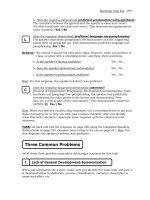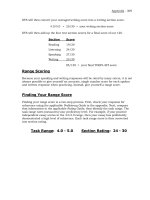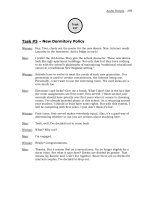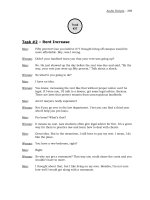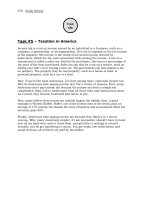Writing to learn instructional strategies for nonfiction writing
Bạn đang xem bản rút gọn của tài liệu. Xem và tải ngay bản đầy đủ của tài liệu tại đây (1.13 MB, 49 trang )
Writing to Learn:
Instructional Strategies for
Nonfiction Writing
Presented by:
Center for Performance Assessment
www.MakingStandardsWork.com
(800) 844-6599
Writing to Learn:
Instructional Strategies for
Nonfiction Writing
Presented by the
Center for Performance Assessment
(800) 844-6599
www.MakingStandardsWork.com
Optimal Learning Environment
Welcome! ☺
Complete engagement and respect
Electronic devices in silent mode
Materials
Agenda
Putting the Puzzle Together
What to
teach
Meet
individual
student
needs
Monitor
learning –
Provide
feedback
How to
teach it
© 2006 by Center for Performance Assessment
All rights reserved. Copy only with permission. (800) 844-6599
Writing to Learn: Instructional Strategies for
Nonfiction Writing
Page P-1
Nonfiction Writing
Where Are You Now?
Developing
Expertise
Getting
Comfortable
Experimenting
Learning
2
1
I know a few
strategies for
NF writing
but have
little
experience
using them
I use some
strategies
for NF
writing and
get mixed
results
4
3
I use
several
different
strategies
for NF
writing and
get good
results
I use many
strategies
for NF
writing and
get
excellent
results
Today’s Objectives
Review the rationale for using more
nonfiction writing as a strategy
Practice specific nonfiction writing
strategies
Create plans for using the strategies
immediately in the classroom
Consider ways to track student
achievement data related to the use of
the strategies
© 2006 by Center for Performance Assessment
All rights reserved. Copy only with permission. (800) 844-6599
Writing to Learn: Instructional Strategies for
Nonfiction Writing
Page P-2
Instructional
Strategies
Knowing
Doing
Applying
Monitoring
Why Write?
Writing can activate background
knowledge
Writing can increase engagement,
especially when used in conjunction
with talking/sharing activities
Students can feel more in control of
their learning when using writing
regularly
Math, Science,
Social Studies, M.C. Tests
“I Don’t Have the Time for More
Writing” Hypothesis
“If we spend more time on
effective assessment, we
won’t have time to cover all
the curriculum and our test
scores will decline.”
Writing Assessment Time and Results
© 2006 by Center for Performance Assessment
All rights reserved. Copy only with permission. (800) 844-6599
Writing to Learn: Instructional Strategies for
Nonfiction Writing
Page P-3
Is the Hypothesis True?
Math, Science,
Social Studies, M.C. Tests
“As time devoted to
writing increases, test
scores increase.”
Source: NASSP Bulletin, Dec.
2000, “Standards Are Not Enough”
Writing Assessment Time and Results
More Writing Increases Test Scores
3rd Grade
English
Correlation
Math = .88
History = .87
Science = .86
5th Grade
Writing
Correlation
Math = .77
History = .75
Science = .85
8th Grade
Writing
Correlation
Math = .83
History = .79
Science = .86
Virginia Department of Education, 1998
Simply Stated...
Writing enhances content area learning!
© 2006 by Center for Performance Assessment
All rights reserved. Copy only with permission. (800) 844-6599
Writing to Learn: Instructional Strategies for
Nonfiction Writing
Page P-4
Students Need to Improve
Writing!
80% of 4th and 8th graders taking the
2002 National Assessment of
Educational Progress writing test
scored in the basic range
The Reading-Writing Connection
Using strategies like journal writing,
learning logs, entrance/exit slips, looping,
cinquains, and KWL assists students in
learning reading through writing
Why Write?
Writing, more than any other subject, can lead
to personal breakthroughs in learning.
Writing is a highly complex act that demands
the analysis and synthesis of many levels of
thinking.
Writing develops initiative. In reading,
everything is provided. In writing, the learner
must supply everything...
© 2006 by Center for Performance Assessment
All rights reserved. Copy only with permission. (800) 844-6599
Writing to Learn: Instructional Strategies for
Nonfiction Writing
Page P-5
Why Write?
Writing develops courage. At no point is the
learner more vulnerable than in writing.
Writing can contribute to reading from the
first day of school.
Writing contributes strongly to reading
comprehension as children grow older. The
ability to revise writing for greater power and
economy is one of the higher forms of
reading.
Why Write?
Writing contributes to a sense of
connection and personal efficacy by
participation in society.
Writing, particularly with evaluation,
editing, revision, and rewriting, will
improve the ability of a student to
communicate and succeed on state and
local writing assessments.
Reason to Write, D. Reeves
Quick Write: Your Response
Think about the information presented
Write for 2 minutes, silently and
nonstop, about what you’re thinking
We’ll debrief as a whole group after 2
minutes
© 2006 by Center for Performance Assessment
All rights reserved. Copy only with permission. (800) 844-6599
Writing to Learn: Instructional Strategies for
Nonfiction Writing
Page P-6
Engaging
Processing
Demonstrating
Understanding
Knowing the Strategies:
Engaging
Entrance slips
Quick writes
Prediction/hypothesis paragraphs
KWL writing
Doing: Let’s Try It!
© 2006 by Center for Performance Assessment
All rights reserved. Copy only with permission. (800) 844-6599
Writing to Learn: Instructional Strategies for
Nonfiction Writing
Page P-7
KWL: Volcanoes
What I Know
about Them
What I Want to
Learn about
Them or What
I Wonder
(Later)
What I
Learned about
Them
Prediction Paragraphs and
KWL: Debriefing
Predicting/hypothesizing activities can
result in percentile gains as high as
28 points
What benefits do you see of these two
activities?
How could you use prediction
paragraphs and KWL writing?
What activities could be done AFTER
these to extend the learning?
© 2006 by Center for Performance Assessment
All rights reserved. Copy only with permission. (800) 844-6599
Writing to Learn: Instructional Strategies for
Nonfiction Writing
Page P-8
Applying:
How Will I Use This?
Entrance slips
Quick writes
Prediction/hypothesis paragraphs
KWL writing
Knowing the Strategies:
Processing
Summary paragraphs
Double-entry journals
Cubing
Doing: Let’s Try It!
Summary paragraph
Debriefing
© 2006 by Center for Performance Assessment
All rights reserved. Copy only with permission. (800) 844-6599
Writing to Learn: Instructional Strategies for
Nonfiction Writing
Page P-9
Why Summarize?
Study
Percentile Gain
Pflaum, et al., 1980
25
Crismore, 1985
27
Rosenshine & Meister,
1994
35
Hattie, et al., 1996
31
Rosenshine, et al., 1996
31
Raphael & Kirschner,
1985
47
Doing: Let’s Try It!
Double-entry journals
Can be used with reading, listening,
watching
Doing: Let’s Try It!
Cubing
Describe
Compare
Associate
Analyze
Argue for/against
© 2006 by Center for Performance Assessment
All rights reserved. Copy only with permission. (800) 844-6599
Writing to Learn: Instructional Strategies for
Nonfiction Writing
Page P-10
Processing Strategies:
Debriefing
What thought processes did you go
through?
What writing processes did you go
through?
How could writing in these types of
non-threatening situations increase
learning?
Applying:
How Will I Use This?
Summary paragraphs
Double-entry journals
Cubing
Knowing the Strategies:
Demonstrating Understanding
Shared expectations among faculty
Define “essay”
Prewriting strategies
Revision strategies
Editing strategies
© 2006 by Center for Performance Assessment
All rights reserved. Copy only with permission. (800) 844-6599
Writing to Learn: Instructional Strategies for
Nonfiction Writing
Page P-11
The Academic Essay
Definition
Characteristics
Word
Examples
Essay
Non-Examples
Doing: Prewriting Strategies
Cubing
ABC lists/taxonomies
Graphic organizers
Helping hand (teach 5-paragraph essay)
Flow chart (expository)
Tree diagram (expository)
Double cell diagram or compare/contrast
web (expository and analytical)
Doing: Let’s Try It!
ABC list/taxonomy
Debriefing
© 2006 by Center for Performance Assessment
All rights reserved. Copy only with permission. (800) 844-6599
Writing to Learn: Instructional Strategies for
Nonfiction Writing
Page P-12
Doing: Let’s Try It!
Graphic organizers
The helping hand
to teach essay
structure
Other organizers
to help students
generate and
organize ideas
Doing: Let’s Try It!
Importance of persuasive writing
PEAS organizer
Applying:
How Will I Use This?
Table discussion, 6-7 minutes
Select one or two ideas to share with
whole group
Reporter will be designated and have 1
minute of preparation time
© 2006 by Center for Performance Assessment
All rights reserved. Copy only with permission. (800) 844-6599
Writing to Learn: Instructional Strategies for
Nonfiction Writing
Page P-13
Doing: Drafting Strategies
Teach someone else
Assume a persona or take a
perspective
Role
Zookeeper
Audience
Visitors to
the zoo
Form
Brochure
Topic
“All About
Our
Mammals”
Kindergarten Kindergarten Lecture
teacher
students
“Mammals
You See in
Everyday
Life”
Household
pet
Family that
owns the pet
Letter
Taking care
of the animal
properly
Biologist
Local
citizens
Presentation
at local
government
meeting
An
endangered
mammal
Doing: Let’s Try It!
Role
Audience
Form
Topic
© 2006 by Center for Performance Assessment
All rights reserved. Copy only with permission. (800) 844-6599
Writing to Learn: Instructional Strategies for
Nonfiction Writing
Page P-14
Applying: How Will I Use This?
Having students write as if they are
teaching someone else
Having students write using different
perspectives
The RAFT framework
Knowing:
Revising and Editing Strategies
Self
Peers
Teacher
Research Writing
Completing a research paper is like
assembling a puzzle. While the
complexity of the puzzle grows as
students get older, the essential steps
to solving the puzzle remain the same.
Douglas Reeves, Reason to Write
© 2006 by Center for Performance Assessment
All rights reserved. Copy only with permission. (800) 844-6599
Writing to Learn: Instructional Strategies for
Nonfiction Writing
Page P-15
Research Writing
The paper load—25 to 150 papers on
one topic?
Multigenre research
Real-world authenticity
Outside audiences
Making the Old New
Have you assigned research papers
about...
the Presidents of the United States
famous explorers, inventors, mathematicians
scientific discoveries
a country or state?
How can we ENLIVEN these
assignments?
Monitoring: Did It Work?
The value of formative assessment
The value of tracking student
performance data
© 2006 by Center for Performance Assessment
All rights reserved. Copy only with permission. (800) 844-6599
Writing to Learn: Instructional Strategies for
Nonfiction Writing
Page P-16
Monitoring: Did It Work?
Collaboratively
Individually
Assess
Research
Reflect
Innovate
Verify
Evaluate
Evaluation and Feedback
Your ideas and reflections are important to
us. Please take time to complete the short
evaluation form that we reviewed at the
beginning of this seminar.
Center for Performance Assessment
(800) 844-6599
www.MakingStandardsWork.com
© 2006 by Center for Performance Assessment
All rights reserved. Copy only with permission. (800) 844-6599
Writing to Learn: Instructional Strategies for
Nonfiction Writing
Page P-17
Center for Performance Assessment
(800) 844-6599
www.MakingStandardsWork.com
© 2006 by Center for Performance Assessment
All rights reserved. Copy only with permission. (800) 844-6599
Writing to Learn: Instructional Strategies for
Nonfiction Writing
Page P-18
Writing to Learn: Instructional Strategies for
Nonfiction Writing (Seminar 2)
Notes about the Agenda and
Logistics
Notes about Materials
Learning Objectives
z Review the rationale for using more nonfiction writing as a strategy
z Practice specific nonfiction writing strategies
z Create plans for using the strategies immediately in the classroom
z Consider ways to track student achievement data related to the use of the
strategies
Strategies
z Knowing
z Doing
z Applying
z Monitoring
© 2006 by Center for Performance Assessment
All rights reserved. Copy only with permission. (800) 844-6599
Writing to Learn: Instructional Strategies support docs
Page S-1
Rationale: Why Write?
Information
Personal Connections
Quick Write: Your Response
Write silently and nonstop for 2 minutes in reaction to the information presented.
Then we’ll debrief.
© 2006 by Center for Performance Assessment
All rights reserved. Copy only with permission. (800) 844-6599
Writing to Learn: Instructional Strategies support docs
Page S-2
Strategies for Engaging
z Entrance slips
z Quick writes
z Prediction/hypothesis paragraphs
z KWL writing
Quick Writes
Rules: Write as fast as possible. No censoring, editing, or talking. How and when
could this strategy be used in your classes?
QUICK WRITES can be done during a teacher’s lecture, instructional video, etc.
Prediction Paragraph Frame (Example):
My teacher has asked me to make predictions/form hypotheses about _____.
The things I see in the photograph include _____. (Add a few sentences of
description and/or tell what you think it is.) I think we are going to study this
because _____. I would also like to learn about _____. These are my initial
predictions/hypotheses.
Your Prediction Paragraph:
© 2006 by Center for Performance Assessment
All rights reserved. Copy only with permission. (800) 844-6599
Writing to Learn: Instructional Strategies support docs
Page S-3
KWL Chart
What I Know about
Them
What I Want to Learn
about Them or What I
Wonder
(Later)
What I Learned about
Them
Prediction Paragraphs and KWL: Debriefing
z What benefits do you see of these two activities?
z How could you use prediction paragraphs and KWL writing?
z What activities could be done AFTER these to extend the learning?
Calendar Template
M
T
W
Th
F
This week
Æ
Next week
Æ
© 2006 by Center for Performance Assessment
All rights reserved. Copy only with permission. (800) 844-6599
Writing to Learn: Instructional Strategies support docs
Page S-4
Strategies for Processing
z Summary paragraphs
z Double-entry journals
z Cubing
Create a Summary:
• Within three minutes, write a summary of your day so far.
• Then there will be three minutes for you to pair-share.
• We will then debrief the process as a whole group.
Your Summary:
© 2006 by Center for Performance Assessment
All rights reserved. Copy only with permission. (800) 844-6599
Writing to Learn: Instructional Strategies support docs
Page S-5
Rules for Summarizing:
Keep
Delete
Substitute
The “Safety Net” Curriculum
What is the Safety Net Curriculum?
The Safety Net is a very limited set of learning objectives organized for each
grade and for each subject. It is not the total curriculum – just the “safety net”
that every teacher should ensure that every student knows.
What Is the Purpose of the Safety Net Curriculum?
The purpose of the Safety Net is to empower teachers to make wise decisions
about what is most important in the curriculum. The Safety Net is not a device to
ignore everything else in the curriculum, but rather a mechanism to help teachers
separate the critical elements of a curriculum from learning objectives that are
less important. Different teachers will make different choices, depending on the
needs of their students, about what they will cover outside of the safety net. But
every teacher should ensure that every student understands the items inside of
the Safety Net. The simple truth is this: few teachers ever cover the entire
textbook or the entire curriculum. Often the decision about what to cover is based
on sequence – we cover the items that are listed early in the curriculum
document or textbook, and so we do not cover the items that are listed late in
those documents. The Safety Net offers a better alternative: student learning of
what is most important. The focus of the Safety Net is on learning, not on mere
coverage. The Safety Net acknowledges that different teachers cover different
curriculum in their classroom based on different interests and varying student
needs. However, every student in the district deserves an equal opportunity for
learning Safety Net standards. However different teaching approaches may be
from one teacher to another, the Safety Net allows every student in the district an
opportunity for learning what is most essential. From the teacher’s point of view,
the Safety Net rejects the approach of some states that insist on micromanagement of daily lesson plans and district-imposed daily learning objectives.
Rather, the Safety Net provides teachers with broad discretion on teaching and
curriculum provided that the students have achieved the Safety Net objectives.
What’s Wrong with the Standards and Curriculum We Already Have?
Many teachers and administrators have complained that traditional standards,
curricula, and textbooks are too voluminous to have practical value. Some
analysts, such as Robert Marzano of the Mid-Continent Educational Research
Lab, have concluded that most states would require school years almost double
their present length in order to adequately cover existing standards. The Safety
Net provides some focus so those teachers can have a common understanding
© 2006 by Center for Performance Assessment
All rights reserved. Copy only with permission. (800) 844-6599
Writing to Learn: Instructional Strategies support docs
Page S-6

